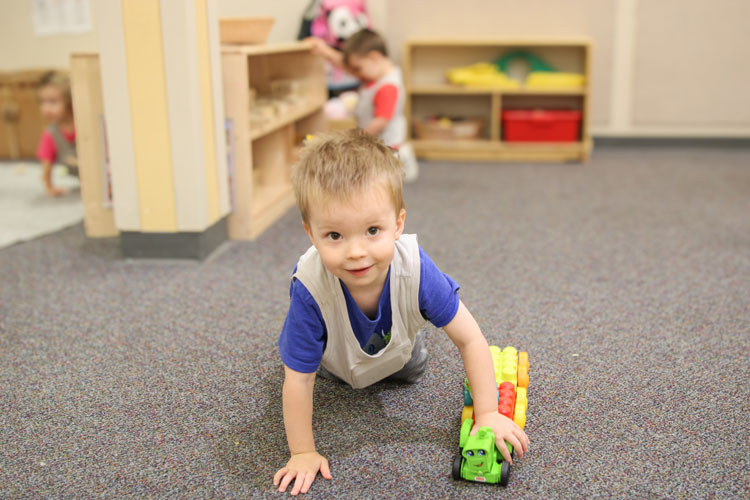Inside Education and Health Sciences

Teaching Literacy by Modeling Language
By Emily Clemenson
On a warm fall day, 2-year-old Anthony went to his classroom at the Bombeck Family Learning Center. After signing him in and sharing the requisite seven hugs, Anthony walked over to his teacher and, before going on to play, he donned a little gray vest with a pocket the size of a cassette tape in the front.
The vest is part of the research component of a grant awarded to Preschool Promise to increase literacy development in young children. This is the fourth year of the grant and the second year that the Bombeck Family Learning Center has been involved with the research, led by Dr. Amy Kronberg, a UD alumna, adjunct faculty member, and parent to an infant who attends Bombeck.
Kronberg is the senior manager for Early Learning Initiatives at Preschool Promise and the lead grant manager. Her connection to UD began in 2013 when she started a master's degree in Early Childhood Leadership and Advocacy through the Department of Teacher Education. She worked as a research assistant with Dr. Shauna Adams, has been teaching as an adjunct for several years, and just finished her Ph.D. in Educational Leadership & Administration.
The purpose of the grant is to "build on ongoing work to improve the language and literacy development of our state’s children," according to an Ohio Department of Education web page describing the grant. This is the first time that children younger than kindergarten are allowed to be included in a grant like this, and the allocation of money awarded to Preschool Promise focuses on children from birth to age 3 — possibly the only group to focus exclusively on these youngest learners.
"Learning begins at birth, and those first three years matter," Kronberg said. "Children can't use language they haven't heard. So the goal of this research is to encourage children to vocalize, to talk, and to use language by modeling that language for them."
This brings us back to the vests that little Anthony put on when he arrived at the Bombeck Center that morning in September. The research uses LENA (Language ENvironment Analysis) technology to record vocalizations between young children and their caretakers at six early childhood education centers in Montgomery County. The LENA website describes it as a "FitBit for conversation" that tracks interactions, called conversational turns, where a caretaker speaks to a child and the child makes some sort of vocalized response. Children wear the vest one day per week for five weeks.
In addition to tracking conversational turns in four classrooms at the Bombeck Center, the classroom teachers are also given training on the best ways to have meaningful interactions with babies and toddlers, opportunities to build community with teachers from other sites involved in the research, and meetings with implementation coaches to identify when something is really working and where there are opportunities for improvement.
Amber Keith is the lead teacher in an infant room at the Bombeck Family Learning Center and is in her second year in Kronberg's LENA research.
"To me, LENA has created a new way of being a reflective educator," Keith said. "We look at LENA reports to see what we were doing when our interactions were the highest. Then we can take that and implement it into other times of the day. It's great — especially knowing how important language is at this age."
Morgan Lanham teaches in the same infant room as Keith, and she has really appreciated the support of the implementation coach and the other organizations that are part of the research.
"Our instructor helps us add more effort and purpose behind what we are doing," Lanham said. "It's not just sharing results and big ideas and wishing us good luck; it's actual implementation, with thoughtfulness and intention."
